A Vibration Analysis of the Rubber Inertial Dampers Used in Electrical Vehicles
Abstract
:1. Introduction
2. Model and Methods
3. Results
4. Conclusions
Author Contributions
Funding
Institutional Review Board Statement
Informed Consent Statement
Data Availability Statement
Conflicts of Interest
References
- Gong, D.; Duan, Y.; Wang, K.; Zhou, J.S. Modelling Rubber Dynamic Stiffness for Numerical Predictions of the Effects of Temperature and Speed on the Vibration of a Railway Vehicle Car Body. J. Sound Vib. 2019, 449, 121–139. [Google Scholar] [CrossRef]
- Munyaneza, O.; Sohn, J.W. Modeling and Control of Hybrid MR Seat Damper and Whole Body Vibration Evaluation for Bus Drivers. J. Low Freq. Noise Vib. Act. Control 2021. [Google Scholar] [CrossRef]
- Lukoševičius, V.; Makaras, R.; Rutka, A.; Keršys, R.; Dargužis, A.; Skvireckas, R. Investigation of Vehicle Stability with Consideration of Suspension Performance. Appl. Sci. 2021, 11, 9778. [Google Scholar] [CrossRef]
- Li, L.; Xu, L.; Cui, H.; Abdelkareem, M.A.A.; Liu, Z.; Chen, J. Validation and Optimization of Suspension Design for Testing Platform Vehicle. Shock Vib. 2021, 2021, 1–15. [Google Scholar] [CrossRef]
- Dižo, J.; Blatnický, M.; Gerlici, J.; Leitner, B.; Melnik, R.; Semenov, S.; Mikhailov, E.; Kostrzewski, M. Evaluation of Ride Comfort in a Railway Passenger Car Depending on a Change of Suspension Parameters. Sensors 2021, 21, 8138. [Google Scholar] [CrossRef] [PubMed]
- Liu, L.; Tan, P.; Ma, H.; Yan, W.; Zhou, F. A Novel Energy Dissipation Outrigger System with Rotational Inertia Damper. Adv. Struct. Eng. 2018, 21, 1865–1878. [Google Scholar] [CrossRef]
- Carotti, A.; Turci, E. A Tuning Criterion for the Inertial Tuned Damper. Design Using Phasors in the Argand–Gauss Plane. Appl. Math. Model. 1999, 23, 199–217. [Google Scholar] [CrossRef]
- Claeys, C.C.; Pluymers, B.; Sas, P.; Desmet, W. Design of a Resonant Metamaterial Based Acoustic Enclosure. In Proceedings of the 26th International Conference on Noise and Vibration Engineering, ISMA, Leuven, Belgium, 15–17 September 2014; Volume 325. [Google Scholar]
- Scutaru, M.L.; Vlase, S.; Marin, M.; Modrea, A. New analytical method based on dynamic response of planar mechanical elastic systems. Bound. Value Probl. 2020, 2020, 104. [Google Scholar] [CrossRef]
- Wang, P.; Su, Z.; Lai, L.; Jiang, H.; Wang, J. Engine Isolate Mount Elastomers. In Proceedings of the 2015 International Conference on Structural, Mechanical and Material Engineering (ICSMME 2015), Dalian, China, 6–8 November 2015; pp. 5–9. [Google Scholar]
- Santhosh, S.; Velmurugan, V.; Paramasivam, V.; Thanikaikarasan, S. Experimental Investigation and Comparative Analysis of Rubber Engine Mount Vibration and Noise Characteristics. Mater. Today Proc. 2019, 21, 638–642. [Google Scholar] [CrossRef]
- Gong, D.; Zhou, J.; Sun, W. Passive Control of Railway Vehicle Car Body Flexural Vibration by Means of Underframe Dampers. J. Mech. Sci. Technol. 2017, 31, 555–564. [Google Scholar] [CrossRef]
- Tobalina-Baldeon, D.; Sanz-Adan, F.; Martinez-Calvo, M.; Santamaría-Pena, J. Dynamic Tensile Stress-Compressive Stress Behavior of Thermoplastic Matrix Composite Materials Reinforced with Continuous Fiber for Automotive Damping and Anti-Vibration Structural Elements. Materials 2019, 13, 5. [Google Scholar] [CrossRef] [PubMed] [Green Version]
- Huang, C.; Zeng, J.; Luo, G.; Shi, H. Numerical and Experimental Studies on the Car Body Flexible Vibration Reduction due to the Effect of Car Body-Mounted Equipment. Proc. Inst. Mech. Eng. Part F J. Rail Rapid Transit 2016, 232, 103–120. [Google Scholar] [CrossRef] [Green Version]
- Pochivalov, K.V.; Shilov, A.N.; Lebedeva, T.N.; Ilyasova, A.N.; Golovanov, R.Y.; Basko, A.V.; Kudryavtsev, Y.V. Development of Vibration Damping Materials Based on Butyl Rubber: A Study of the Phase Equilibrium, Rheological, and Dynamic Properties of Compositions. J. Appl. Polym. Sci. 2020, 138. [Google Scholar] [CrossRef]
- Velmurugan, V.; Paramasivam, L.V.; Thanikaiarasan, S.; Vaikundraj, T.P. Experimental Investigation on Material Characteristics of NR Mount and Fluorocarbon Blended NRMounts for Diesel Engine On-Road Vehicle. J. New Mater. Electrochem. Syst. 2019, 22, 51–57. [Google Scholar] [CrossRef]
- Thanikaikarasan, S.; Masthanvali, G.; Velmurugan, V. Modeling and Analysis of Car Seat Rubber Bush Using CATIA for Reducing Vibration in Passenger Engine Vehicles. In Proceedings of the International Conference on Technological Advancements in Materials Science and Manufacturing (ICTAMSM), Uttarakhand, India, 19–20 February 2021; Volume 46, pp. 10244–10247. [Google Scholar] [CrossRef]
- Palacz, P.; Major, M.; Adamczyk, I. Reduction of Mechanical Interactions with the Use of a Rubber Composite. In Proceedings of the 22nd International Scientific Conference on Construction-The Formation of Living Environment (FORM), Tashkent, Uzbekistan, 18–21 April 2019; Volume 97, p. 02029. [Google Scholar] [CrossRef]
- Voparil, J.; Prokop, A.; Rehak, K. Influence of a Powertrain Mounting Method on Powertrain Vibration. In Proceedings of the 19th International Conference on Mechatronics-Mechatronika, Prague, Czech Republic, 2–4 December 2020; pp. 200–206. [Google Scholar]
- Liao, L.; Zuo, Y.; Meng, H.; Liao, X. Research on the Technology of Noise Reduction in Hybrid Electric Vehicle with Composite Materials. Adv. Mech. Eng. 2018, 10, 1687814018766916. [Google Scholar] [CrossRef] [Green Version]
- Johnson, D.A. Simulation and Analysis of a Fractionally Controlled Active Suspension using Quarter Car Model. In Proceedings of the ASME International Design Engineering Technical Conferences and Computers and Information in Engineering Conference, Boston, MA, USA, 2–5 August 2015; Volume 57199, p. V009T07A018. [Google Scholar]
- Zhang, H.; Zhang, N.; Min, F.; Rakheja, S.; Su, C.; Wang, E. Coupling Mechanism and Decoupled Suspension Control Model of a Half Car. Math. Probl. Eng. 2016, 2016, 1–13. [Google Scholar] [CrossRef] [Green Version]
- Gong, D.; Zhou, J.; Sun, W.; Sun, Y.; Xia, Z. Method of Multi-Mode Vibration Control for the Carbody of High-Speed Electric Multiple Unit Trains. J. Sound Vib. 2017, 409, 94–111. [Google Scholar] [CrossRef]
- Hartel, V.; Ziegler, W. Elastic Engine Suspension-The Development a System. In Proceedings of the Technical Meeting of the German Rubber Society–The Rubber Industry: A Source of Development and Systems Supply, Homburg, Germany, 19–20 September 1990; Volume 44, p. 90. [Google Scholar]
- Rades, M. Mechanical Vibrations II. Structural Dynamic Modeling; Printech Publishing House: Bucharest, Romania, 2010. [Google Scholar]
- Vlase, S.; Danasel, C.; Scutaru, M.L.; Mihalcica, M. Finite Element Analysis of a Two-Dimensional Linear Elastic Systems with a Plane Rigid Motion. Rom. J. Phys. 2014, 59, 5–6. [Google Scholar]
- Vlase, S.; Teodorescu, P.P.; Itu, C.; Scutaru, M.L. Elasto-Dynamics of a Solid with a General Rigid Motion Using FEM Model. Part II. Analysis of a Double Cardan Joint. Rom. J. Phys. 2013, 58, 7–8. [Google Scholar]
- Vlase, S.; Marin, M.; Scutaru, M.L.; Munteanu, R. Coupled Transverse and Torsional Vibrations in a Mechanical System with Two Identical Beams. AIP Adv. 2017, 7, 6. [Google Scholar]
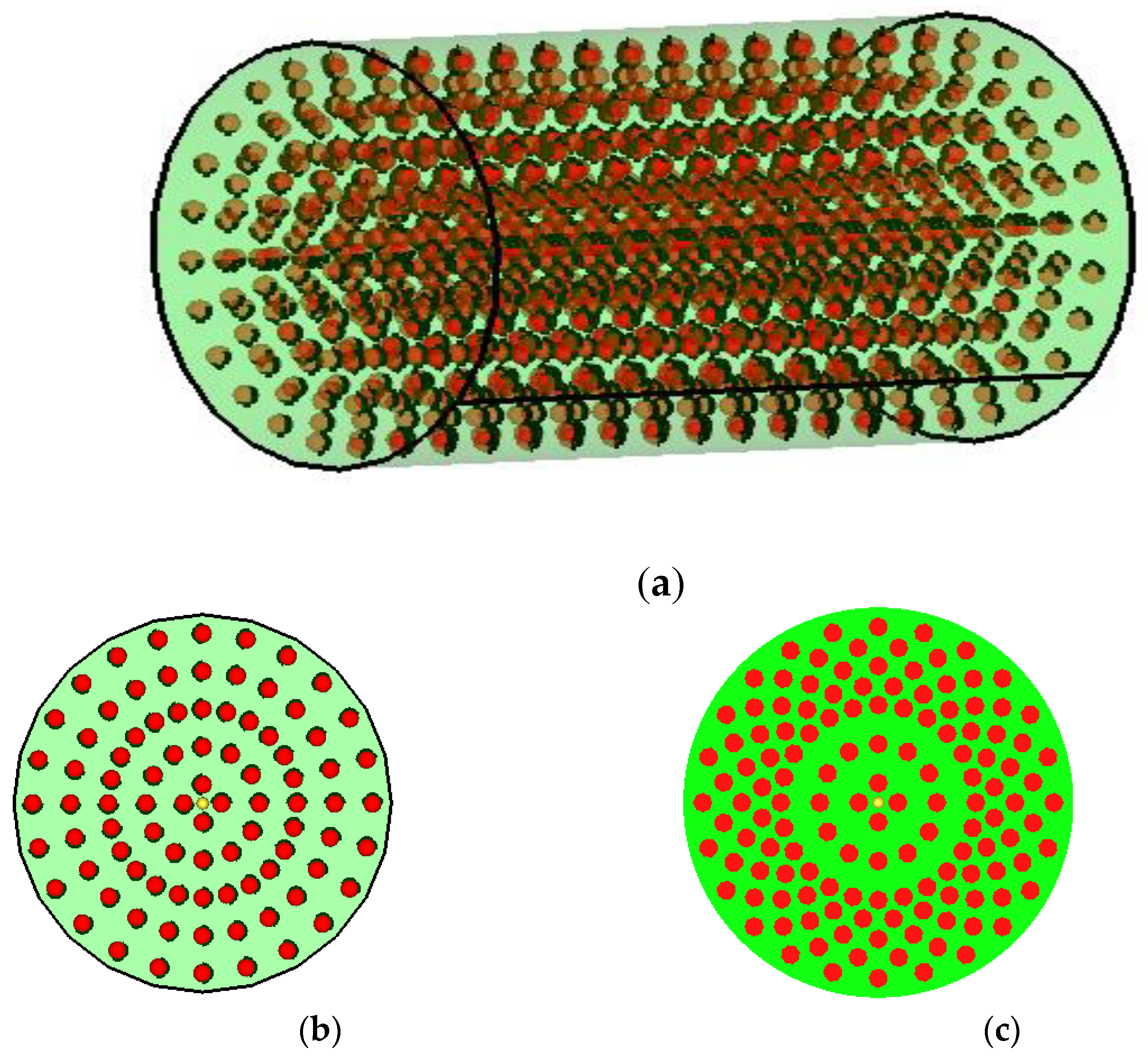
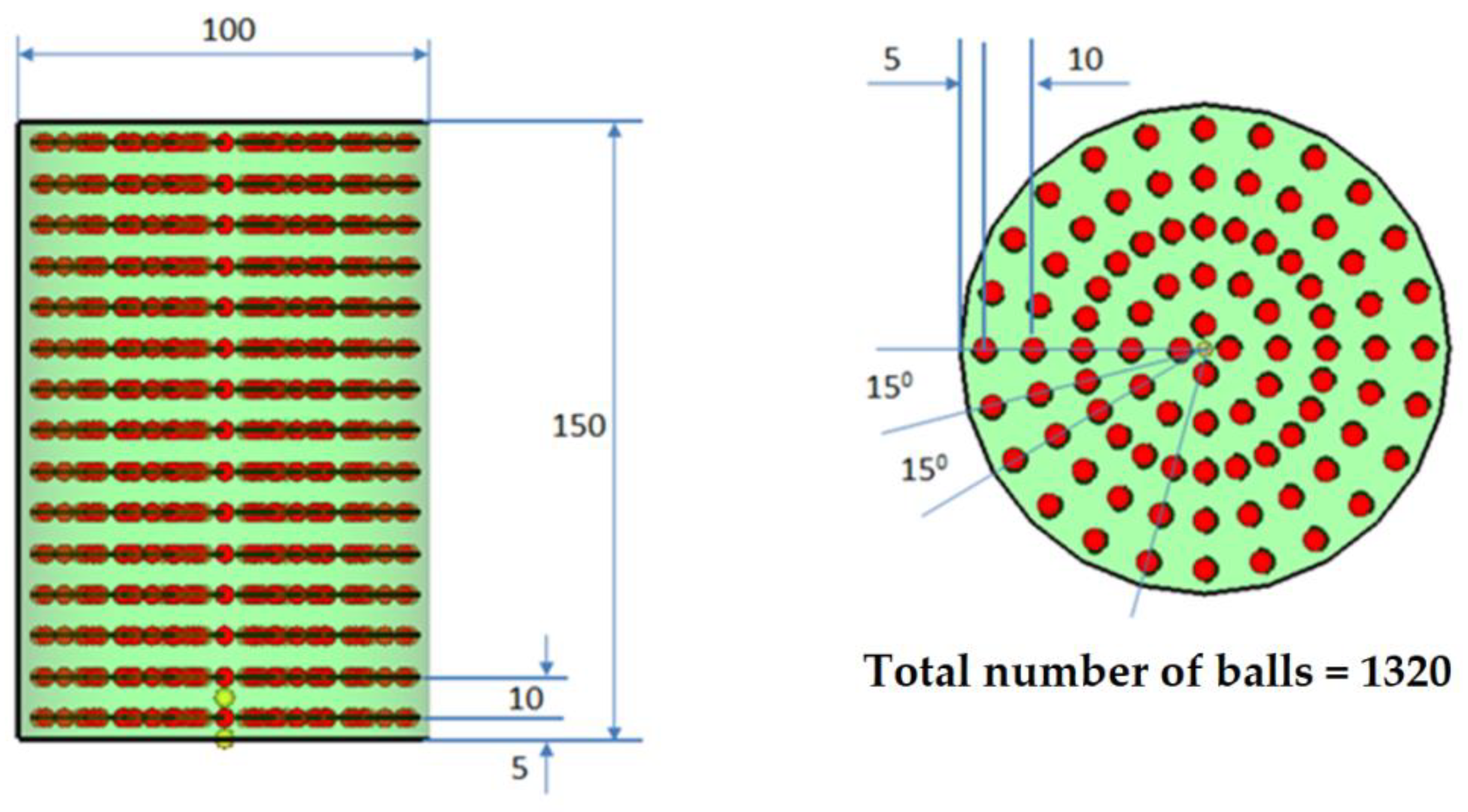

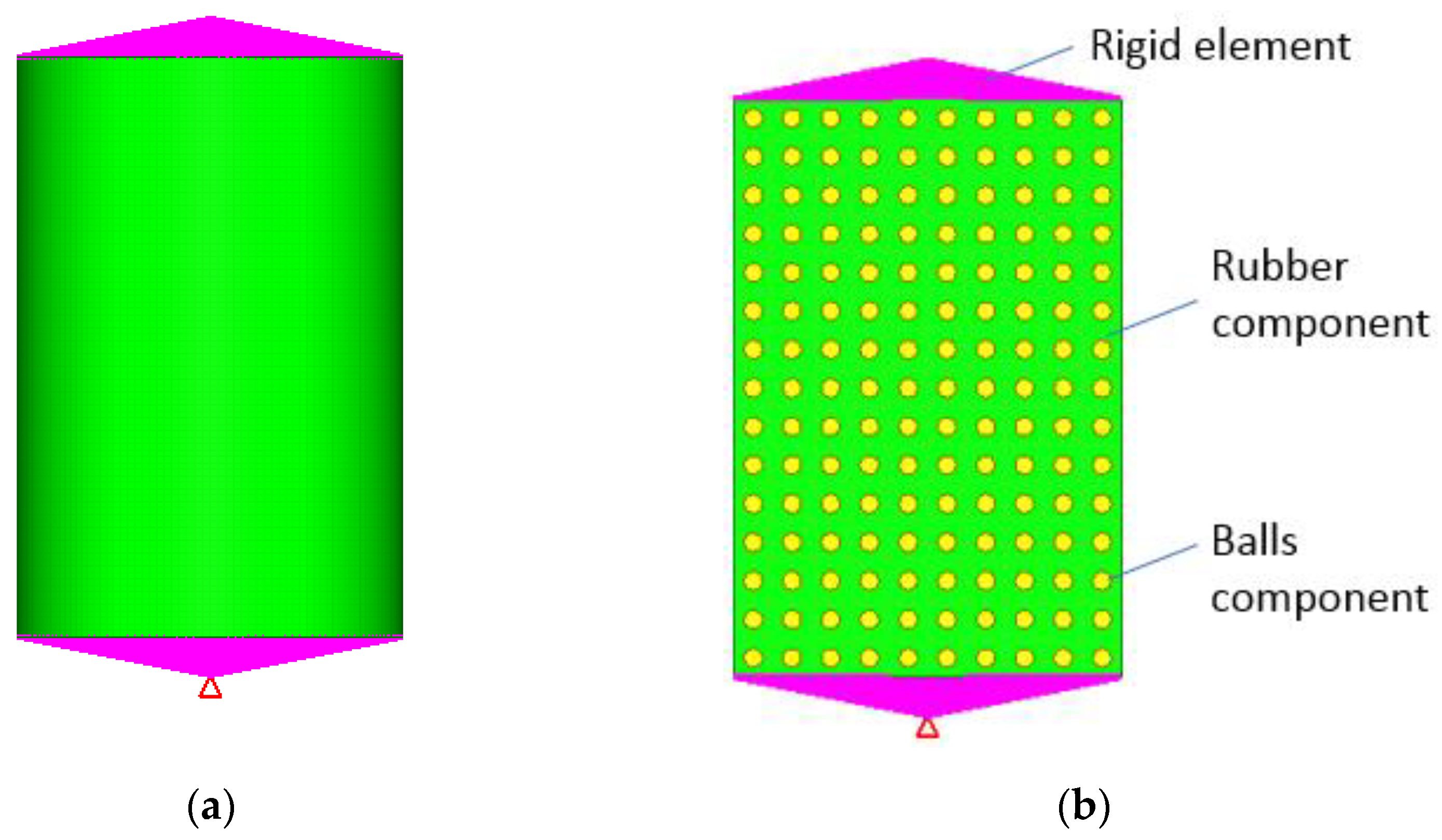
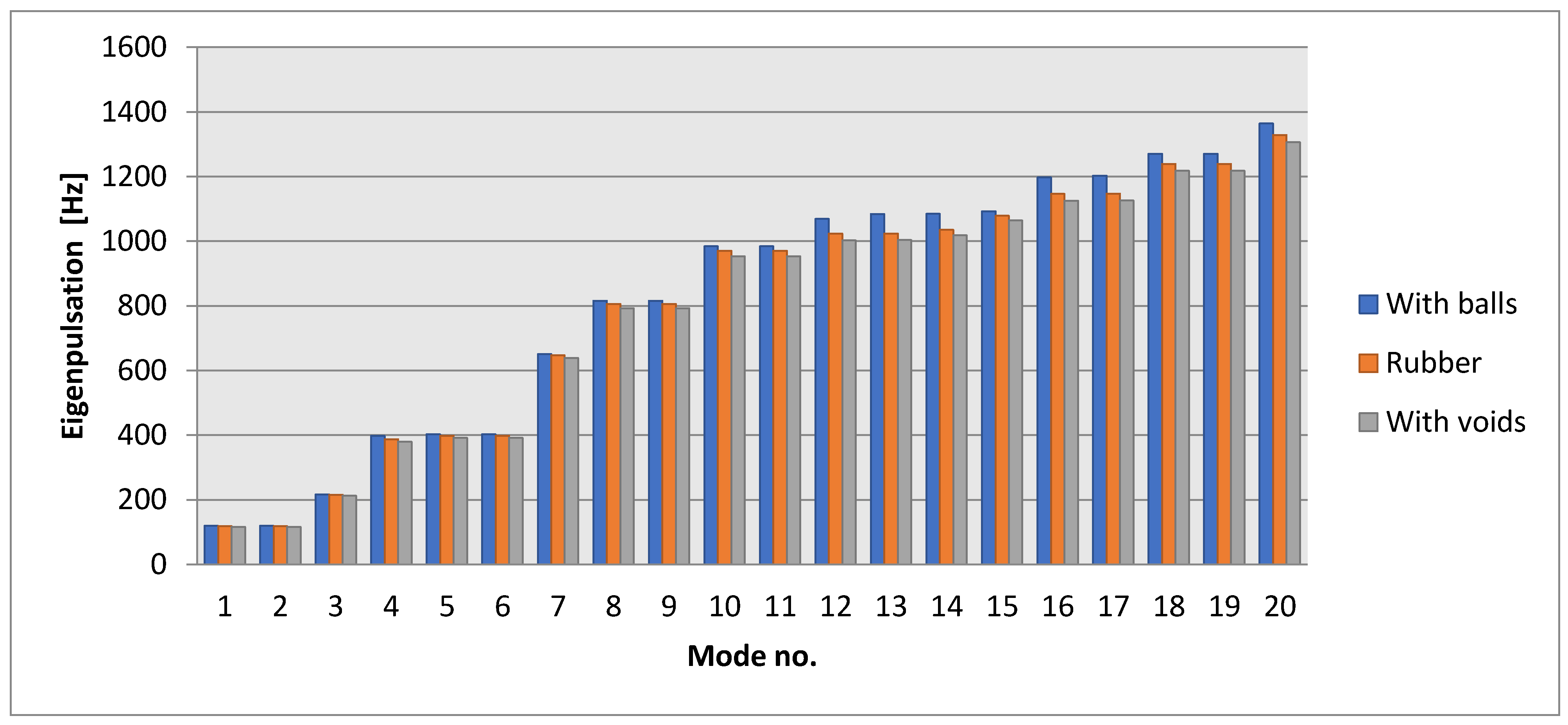

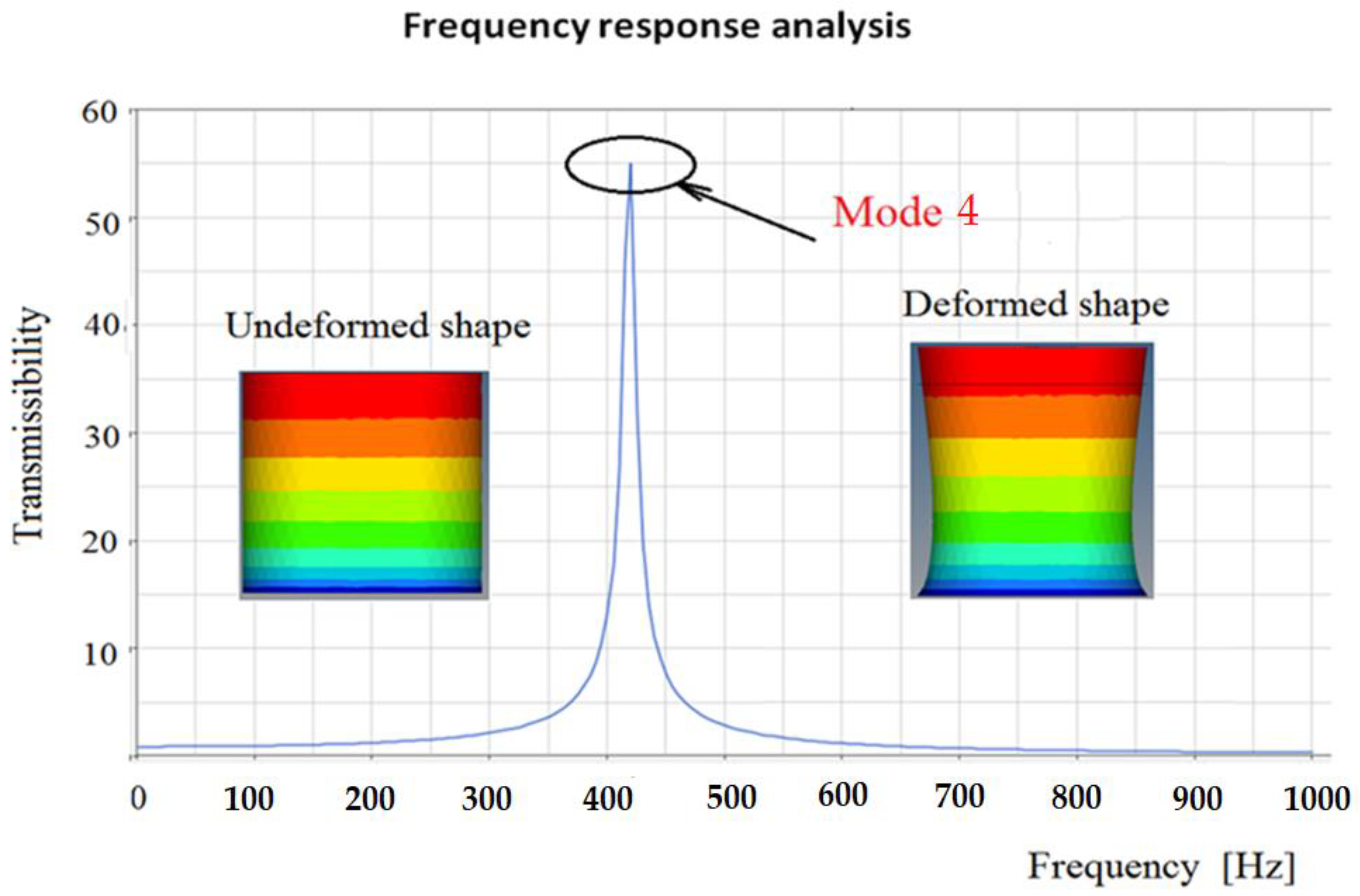
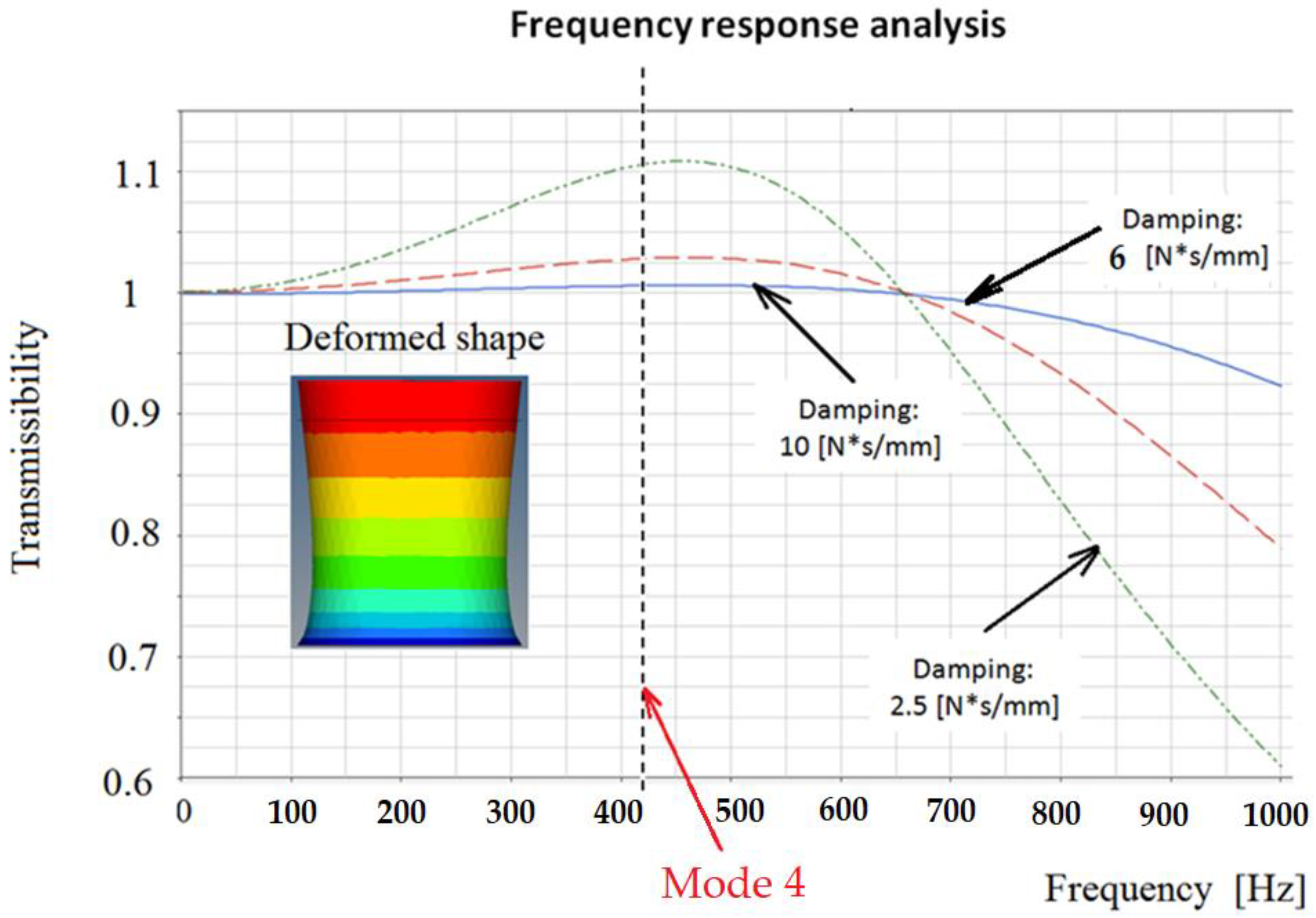
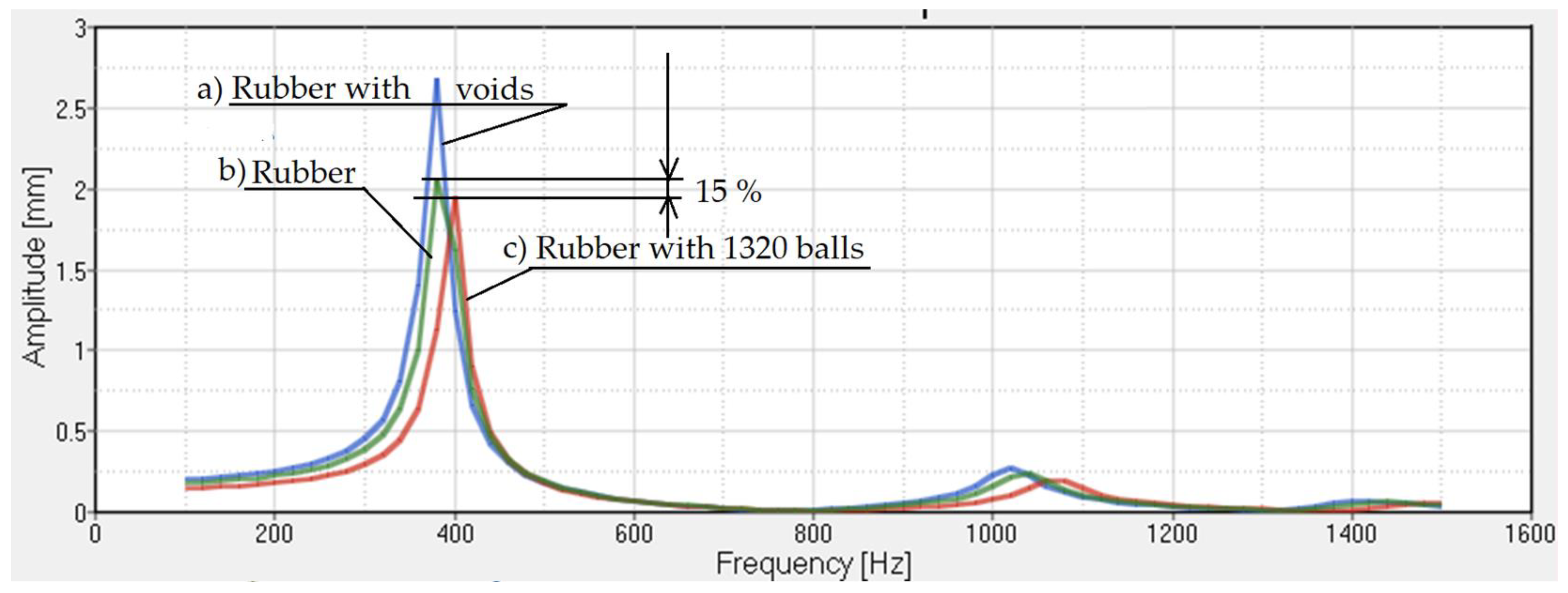
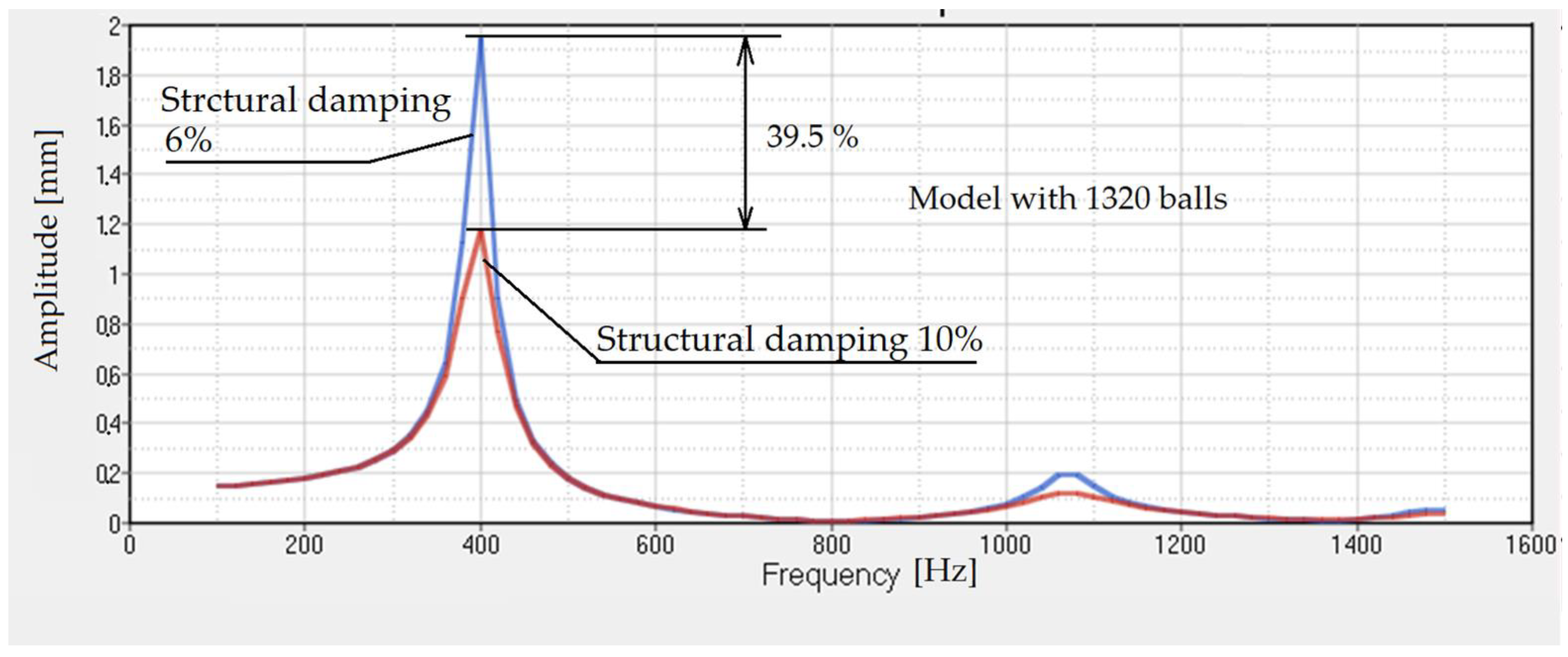
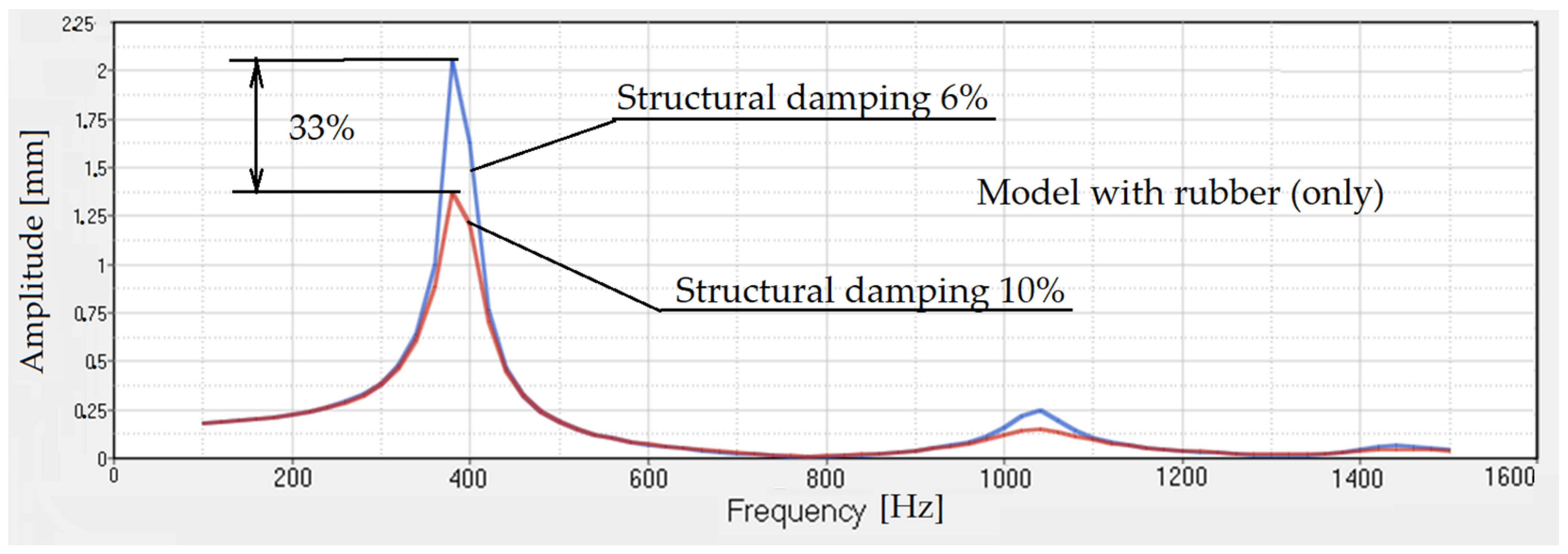



| No. of Radial Rows | No. of Balls | Angle |
|---|---|---|
| 1 | 4 | 90° |
| 2 | 12 | 30° |
| 3 | 24 | 15° |
| 4 | 24 | 15° |
| 5 | 24 | 15o |
| No. of Radial Rows | No. of Balls | Angle |
|---|---|---|
| 1 | 4 | 90° |
| 2 | 12 | 30° |
| 3 | 24 | 15° |
| 4 | 24 | 15° |
| 5 | 24 | 15° |
| 6 | 24 | 15° |
| 7 | 24 | 15° |
| Mode No. | With Steel Balls (N = 1320) | Without Balls (Rubber) | With Voids |
|---|---|---|---|
| The values are expressed in Hz | |||
| 1 | 119.60 | 118.38 | 116.27 |
| 2 | 119.61 | 118.38 | 116.28 |
| 3 | 216.99 | 215.78 | 212.91 |
| 4 | 398.07 | 387.56 | 379.47 |
| 5 | 402.66 | 398.23 | 391.69 |
| 6 | 402.70 | 398.23 | 391.70 |
| 7 | 650.95 | 647.27 | 638.66 |
| 8 | 816.04 | 806.40 | 792.39 |
| 9 | 816.13 | 806.41 | 792.41 |
| 10 | 984.06 | 971.10 | 953.08 |
| 11 | 984.14 | 971.12 | 953.11 |
| 12 | 1069.14 | 1023.75 | 1002.57 |
| 13 | 1083.99 | 1023.77 | 1003.42 |
| 14 | 1084.85 | 1034.82 | 1018.36 |
| 15 | 1092.35 | 1078.58 | 1064.17 |
| 16 | 1197.32 | 1146.70 | 1125.29 |
| 17 | 1202.60 | 1146.72 | 1125.81 |
| 18 | 1270.41 | 1239.27 | 1217.81 |
| 19 | 1270.55 | 1239.27 | 1217.84 |
| 20 | 1364.00 | 1328.27 | 1306.41 |
| Mode No. | With Steel Balls (N = 2040) | Without Balls (Rubber) | With Voids |
|---|---|---|---|
| The values are expressed in Hz | |||
| 1 | 122.47 | 118.38 | 116.27 |
| 2 | 122.55 | 118.38 | 116.28 |
| 3 | 216.72 | 215.78 | 212.91 |
| 4 | 407.58 | 387.56 | 379.47 |
| 5 | 407.79 | 398.23 | 391.69 |
| 6 | 414.52 | 398.23 | 391.70 |
| 7 | 649.91 | 647.27 | 638.66 |
| 8 | 820.46 | 806.40 | 792.39 |
| 9 | 820.87 | 806.41 | 792.41 |
| 10 | 987.31 | 971.10 | 953.08 |
Publisher’s Note: MDPI stays neutral with regard to jurisdictional claims in published maps and institutional affiliations. |
© 2022 by the authors. Licensee MDPI, Basel, Switzerland. This article is an open access article distributed under the terms and conditions of the Creative Commons Attribution (CC BY) license (https://creativecommons.org/licenses/by/4.0/).
Share and Cite
Itu, C.; Vlase, S.; Marin, M. A Vibration Analysis of the Rubber Inertial Dampers Used in Electrical Vehicles. Polymers 2022, 14, 953. https://doi.org/10.3390/polym14050953
Itu C, Vlase S, Marin M. A Vibration Analysis of the Rubber Inertial Dampers Used in Electrical Vehicles. Polymers. 2022; 14(5):953. https://doi.org/10.3390/polym14050953
Chicago/Turabian StyleItu, Calin, Sorin Vlase, and Marin Marin. 2022. "A Vibration Analysis of the Rubber Inertial Dampers Used in Electrical Vehicles" Polymers 14, no. 5: 953. https://doi.org/10.3390/polym14050953
APA StyleItu, C., Vlase, S., & Marin, M. (2022). A Vibration Analysis of the Rubber Inertial Dampers Used in Electrical Vehicles. Polymers, 14(5), 953. https://doi.org/10.3390/polym14050953








